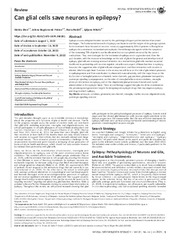| dc.creator | SHEN, Weida | |
| dc.creator | Bogdanović Pristov, Jelena | |
| dc.creator | Nobili, Paola | |
| dc.creator | Nikolic, Ljiljana | |
| dc.date.accessioned | 2023-07-19T11:23:35Z | |
| dc.date.available | 2023-07-19T11:23:35Z | |
| dc.date.issued | 2023 | |
| dc.identifier.issn | 1673-5374 | |
| dc.identifier.uri | http://rimsi.imsi.bg.ac.rs/handle/123456789/2004 | |
| dc.description.abstract | Epilepsy is a neurological disorder caused by the pathological hyper-synchronization of neuronal discharges. The fundamental research of epilepsy mechanisms and the targets of drug design options for its treatment have focused on neurons. However, approximately 30% of patients suffering from epilepsy show resistance to standard anti-epileptic chemotherapeutic agents while the symptoms of the remaining 70% of patients can be alleviated but not completely removed by the current medications. Thus, new strategies for the treatment of epilepsy are in urgent demand. Over the past decades, with the increase in knowledge on the role of glia in the genesis and development of epilepsy, glial cells are receiving renewed attention. In a normal brain, glial cells maintain neuronal health and in partnership with neurons regulate virtually every aspect of brain function. In epilepsy, however, the supportive roles of glial cells are compromised, and their interaction with neurons is altered, which disrupts brain function. In this review, we will focus on the role of glia-related processes in epileptogenesis and their contribution to abnormal neuronal activity, with the major focus on the dysfunction of astroglial potassium channels, water channels, gap junctions, glutamate transporters, purinergic signaling, synaptogenesis, on the roles of microglial inflammatory cytokines, microglia-astrocyte interactions in epilepsy, and on the oligodendroglial potassium channels and myelin abnormalities in the epileptic brain. These recent findings suggest that glia should be considered as the promising next-generation targets for designing anti-epileptic drugs that may improve epilepsy and drug-resistant epilepsy. | sr |
| dc.language.iso | en | sr |
| dc.publisher | Wolters Kluwer – Medknow | sr |
| dc.relation | Grants from European Commission (H2020 MSCA-ITN EU-GliaPhD No. 72205) | sr |
| dc.relation | Agence Nationale de la Recherche, Nos. ANR-19-CE16-0018-03 and ANR-20CE16-0003-02 | sr |
| dc.relation | Grants from Science and Technology Department of Zhejiang Province, China, No. 2021RC051 | sr |
| dc.relation | Scientific Research Foundation for Returned Scholars of Hangzhou City, China, No. 2019 | sr |
| dc.relation | info:eu-repo/grantAgreement/MESTD/inst-2020/200007/RS// | sr |
| dc.relation | info:eu-repo/grantAgreement/MESTD/inst-2020/200053/RS// | sr |
| dc.rights | openAccess | sr |
| dc.rights.uri | https://creativecommons.org/licenses/by/4.0/ | |
| dc.source | NEURAL REGENERATION RESEARCH | sr |
| dc.subject | astrocyte | sr |
| dc.subject | cytokines | sr |
| dc.subject | glutamate | sr |
| dc.subject | ion channel | sr |
| dc.subject | microglia | sr |
| dc.subject | myelin | sr |
| dc.subject | neuron | sr |
| dc.subject | oligodendrocyte | sr |
| dc.subject | purinergic signaling | sr |
| dc.subject | seizures | sr |
| dc.title | Can glial cells save neurons in epilepsy? | sr |
| dc.type | article | sr |
| dc.rights.license | BY | sr |
| dc.citation.epage | 1422 | |
| dc.citation.issue | 7 | |
| dc.citation.spage | 1417 | |
| dc.citation.volume | 18 | |
| dc.description.other | kategorija casopsisa M21 | sr |
| dc.identifier.doi | 10.4103/1673-5374.360281 | |
| dc.identifier.fulltext | http://rimsi.imsi.bg.ac.rs/bitstream/id/5278/bitstream_5278.pdf | |
| dc.type.version | publishedVersion | sr |

